[ Winter 2014 ]
For the past 100 years, donors to Harvard School of Public Health have stepped in at pivotal moments to fund the people, ideas, and infrastructure needed to make lifesaving discoveries and innovations possible. From polio to AIDS, from workplace safety to improving the delivery of humanitarian relief, from obesity prevention to air flight safety—the stories of how donors have emerged from the most unlikely places or at the most difficult times are a fascinating and integral part of the School’s history.
From virtual organization to a permanent place
At Harvard School of Public Health, groundbreaking ideas have always depended on breaking ground—that is, on buildings. The eight students who enrolled in the Harvard-MIT School for Health Officers in 1913 criss-crossed between Boston and Cambridge to take classes, long before shuttle buses made that relatively easy. They studied at Harvard Medical School, at MIT—then located in Boston’s Back Bay neighborhood—or in Harvard’s sanitary engineering department in Cambridge. Sunday afternoon teas at the home of founder George Whipple provided the far-flung campus’s social life.
Looking back a century later, we might consider the School of that era more of a virtual organization, though significantly more difficult to run without computers, websites, and smartphones. Thankfully, a $1.8 million gift in 1922 from the Rockefeller Foundation—the equivalent of $27.8 million today—combined with $1 million from Harvard University, made it possible for the School to acquire an impressive new home at 55 Shattuck Street. Originally built as an infants’ hospital to commemorate the child of the first full professor of pediatrics at Harvard, the edifice was an admirably handsome marble structure with a columned portico and a large foyer. The nursery of the hospital was converted to a recreation room for students. Located just down the street from the medical school’s even grander administrative building, it was in the heart of what is now Boston’s Longwood Medical Area.
A nation on a postwar building spree
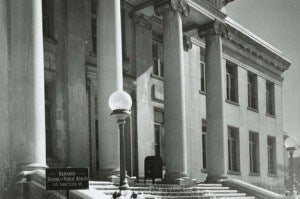 Further building expansion did not occur until after the Depression and World War II, when the School acquired a 40,000-square-foot building on Huntington Avenue that had housed the Huntington Memorial Hospital. By the 1950s, the whole country was on a building spree. Robert Moses was reshaping New York City; the Interstate Highway System was being built; Americans fled to new suburban subdivisions in droves; and the School’s faculty and student enrollment had more than doubled. Lamenting the overcrowding in “two old, reconstructed hospital buildings” that belonged to the School, HSPH Dean James Stevens Simmons proposed a $6.5 million construction program in 1949 (about $64 million in today’s dollars).
Further building expansion did not occur until after the Depression and World War II, when the School acquired a 40,000-square-foot building on Huntington Avenue that had housed the Huntington Memorial Hospital. By the 1950s, the whole country was on a building spree. Robert Moses was reshaping New York City; the Interstate Highway System was being built; Americans fled to new suburban subdivisions in droves; and the School’s faculty and student enrollment had more than doubled. Lamenting the overcrowding in “two old, reconstructed hospital buildings” that belonged to the School, HSPH Dean James Stevens Simmons proposed a $6.5 million construction program in 1949 (about $64 million in today’s dollars).
Simmons died of a heart attack in 1954 and didn’t get to see the School’s physical transformation. His successor, John C. Snyder, after whom the auditorium in the Kresge Building is named, would become the master builder of the School and the person most responsible for the physical campus we know today.
Seed money for what were to become Buildings 1 and 2 came from the Rockefeller Foundation: $275,000 of a $500,000 grant for the study of radiological health was earmarked for construction and equipment. General Foods in 1960 gave $1.03 million ($8.1 million in today’s dollars) for the Nutritional Research Laboratories, which would be housed in these buildings. This was a stunning amount—at the time, the largest corporate gift ever to any part of the University. (In hindsight, there has been criticism that the nutrition department of that era might have been too close to the food industry.) Federal funding was also an essential piece of the pie; the Health Research Facilities Branch of the National Institutes of Health awarded the School two grants totaling $1.45 million (nearly $12 million today) toward the buildings’ nutrition and environmental hygiene research facilities.
Ambitions on shaky ground
By the beginning of 1966, Snyder’s ambitious building program was on shaky ground, however. The first four floors of Building 1 had been occupied in anticipation of adding 11 more floors later. But the School hadn’t come up with the matching funds for grants from the federal government, the Rockefeller Foundation, and the Kresge Foundation. About $4 million (nearly $29 million today) was at stake. Here was another turning point where philanthropy made the difference.
Snyder, who, as a young bacteriologist, had worked on typhus control in the Middle East, set his sights on governments there and on companies that did business in the region. He threw himself into the pursuit of funds so the building could be finished—and by the end of the year, disaster had been averted. The governments of four Middle Eastern countries—Saudi Arabia, Kuwait, Abu Dhabi, and Bahrain—pledged a total of $816,000, about $5.7 million today. Forty corporations promised another $612,000 (or $4.3 million in today’s equivalent). Among the donors listed on the program for the 1969 dedication ceremony of the completed Building 1 was Aristotle Onassis, the Greek shipping tycoon and husband of former first lady Jacqueline Kennedy Onassis.
A dreadful shock
The road to a completed Sebastian S. Kresge Building was also a rocky one. Snyder and other School officials had planned an impressive modern educational facility, with a “comprehensive communications system” featuring extensive use of audiovisual services, television, and computer-assisted instruction. A federal grant of about $7 million ($44 million today) would cover more than half of the cost. When the Kellogg Foundation contributed $1 million toward the project in 1969 ($6.5 million today) and the Mellon Foundation another $250,000 ($1.6 million today), the fundraising seemed adequate.
But later that year, the “School received a dreadful shock,” Snyder wrote in the annual Dean’s Report. Construction costs for the education building had jumped to $16 million from $12 million, and because of tax issues, a gift of Florida real estate that the School and Snyder were counting on to bankroll the building was worth $1.5 million instead of the original estimate of $4 million. The situation looked dire—and catastrophically embarrassing—until the Kresge Foundation agreed to contribute $2.6 million ($16.5 million today) in exchange for the naming rights.
Philanthropy saves the day—again
At the dedication of the Kresge Building in May 1975, the president of the foundation, William Baldwin, told the audience that he had gone to summer camp in northern Michigan with Thomas Weller, the powerful chair of the Department of Tropical Medicine who had shared in the 1954 Nobel Prize in Physiology or Medicine. “I remember Tom as that towheaded kid who used to hang around the nature hut,” recalled Baldwin. “As the twig is bent, so is the tree inclined!”
For the next 15 years, the School’s basic physical dimensions stayed roughly the same, and fundraising concerns shifted to bolstering the endowment. In 1992, the construction hiatus ended when Countess Albina du Boisrouvray made a $20 million gift to build the François-Xavier Bagnoud (FXB) Building, named for her son, who had died in a helicopter accident when he was 24.
Infrastructure: A growing challenge
While Harvard Medical School and hospitals around HSPH expanded significantly over the next 20 years, HSPH’s building aspirations were met instead by renting space. Today, the School’s activities are housed in the four main buildings it has owned for decades—Buildings 1 and 2, Kresge, and FXB—and an amalgamation of other rented facilities that range from storefronts on Huntington Avenue to a refurbished Catholic school in nearby Mission Hill. Plans for a potential move of some or all of the School’s work to significant permanent space on Harvard’s proposed new Allston campus were stalled by the “Great Recession” that began in 2008. But with buildings and facilities showing their age, the challenge is only growing.
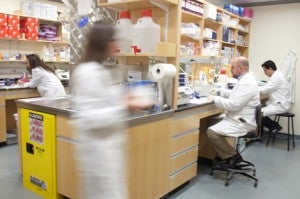
As the School enters its second century, its infrastructure priorities are broad and ambitious. Faculty and students engaged in 21st-century learning and research need 21st-century facilities and technologies to accomplish their goals. There is a focus on redesigning classrooms to meet the needs of today’s public health education—not unlike the vision for the Kresge Building in the 1960s. Hearkening back to the early days of a “virtual” School dispersed around the city, HSPH is investing in massive open online courses via HarvardX. (Ronay and Richard Menschel, MBA ’59, are among those who have made generous contributions to these endeavors.) And as scientific advances make it possible to generate giant banks of information, technological resources are critical for translating “big data” into meaningful public health interventions.
And so, just as constructive research over the past 100 years has required construction of places and spaces in which scientific discovery can bloom, the same will likely hold true in the next century as well.
Igniting discovery
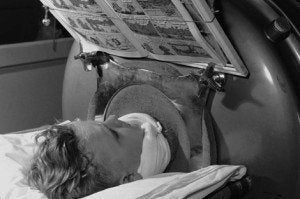
In 1928, the New York Consolidated Gas Company gave HSPH’s Philip Drinker $500 (about $6,800 in today’s dollars) to develop a breathing device that could save people injured by electric shocks and gas leaks. Working with colleague Louis Agassiz Shaw, Drinker built an early prototype of the machine that would become known as the iron lung—an invention that went on to far exceed the original mission, saving the lives of thousands of people stricken by polio. Put simply, a timely and enlightened investment in public health changed the world.
This story is just one illustration of the myriad ways gifts from private donors, combined with government funding, have ignited lifesaving—and world-changing—ideas and discoveries at Harvard School of Public Health.
Dangerous work environments
During the School’s early history, perilous and unhealthy working conditions in factories had become a national concern. The School’s flagship program was “industrial hygiene”—the study of the health effects of working conditions—and faculty members Alice Hamilton, Cecil Drinker, and David Edsall pioneered the study of toxic exposures in factories and other workplaces. In 1918, one of the first major gifts to benefit the School totaled $125,000—equal to $1.93 million today—from a group of New England manufacturers to establish courses for factory physicians in the field of industrial hygiene.
Philanthropy makes flight safer
Decades later, a postwar boom in air travel led to a $250,000 gift (about $2 million today) from the Guggenheim Fund in 1957 to create the Center for Aviation Health and Safety, led by Ross McFarland, a renowned expert on the effects of altitude and fatigue on pilots. McFarland studied how oxygen deprivation can cloud judgment, evaluated the size and illumination of instrument panels on planes to see if they were legible at extreme speeds, and worked with Pan American Airlines to study pilot fatigue on long flights. The warning still heard on every commercial airline flight—“In the unlikely event of a drop in cabin pressure…”—is the result of research conducted by McFarland and his team.
Funding the earliest AIDS research
The catalytic effect of private philanthropy on government investment is perhaps nowhere more evident than in HIV/AIDS research. When the AIDS epidemic exploded in the early 1980s, the U.S. government was slow to react. It was private philanthropy that underwrote the earliest efforts to slow and prevent the infection. With critical gifts from philanthropists such as Maurice Tempelsman and Mary Woodard Lasker, the School was able to respond to the epidemic and established the Harvard AIDS Institute in 1988, bringing disparate AIDS research efforts around the University under one roof.
HSPH was also a timely leader in research and prevention of AIDS in Africa, thanks to Deeda Blair, a volunteer and donor who introduced Tempelsman and the many business and government contacts he had in Africa to the School. In 1985, while working as a graduate student in the Essex laboratory, Phyllis Kanki, SD ’85, now professor of immunology and infectious diseases, discovered a previously unknown form of the human immunodeficiency virus (HIV), which causes AIDS. While HIV-1 is responsible for most infections in the United States, the form of the virus that Kanki discovered, HIV-2, predominates in West Africa and is less virulent than HIV-1—qualities that lend it scientific interest.
In 2000, Kanki won a $25 million grant from the Bill & Melinda Gates Foundation to study AIDS in Nigeria. In 2003, President George W. Bush, MBA ’75, announced the $15 billion President’s Emergency Plan for AIDS Relief. Over the next 10 years, HSPH received a total of approximately $390 million from PEPFAR for work in Nigeria, Botswana, and Tanzania, largely led by Kanki; it was the largest government grant in Harvard University’s history.
Kids and obesity prevention
As the HIV/AIDS history makes clear, government funding has been critical to public health progress. That said, in an era of budgetary constraints and fiscal uncertainty, private philanthropy is an increasingly important complement, fueling early research and on-the-ground progress in areas of pressing need.
 One of these areas is nutrition and obesity. In 2003, Paul Finnegan, AB ’75, MBA ’82, and his wife Mary Finnegan made a gift of $250,000 to provide seed money for two initiatives—one to uncover possible genetic links between obesity and asthma, the other to fund a program by Steven Gortmaker, director of the HSPH Prevention Research Center, to develop new curricula that teachers in after-school programs, as well as coaches and staff in school athletic programs and summer camps, can use to improve nutrition and physical activity in youth. In 2006, Harvard College alumna Penny Pritzker, AB ’81, and her husband, Bryan Traubert—the parents of two healthy, active adolescents—pledged $5 million to launch an initiative to promote health and prevent obesity among children nationwide through the Donald and Sue Pritzker Nutrition and Fitness Initiative, named to honor Pritzker’s parents. Eight years later, those investments have paid—and continue to pay—extraordinary dividends.
One of these areas is nutrition and obesity. In 2003, Paul Finnegan, AB ’75, MBA ’82, and his wife Mary Finnegan made a gift of $250,000 to provide seed money for two initiatives—one to uncover possible genetic links between obesity and asthma, the other to fund a program by Steven Gortmaker, director of the HSPH Prevention Research Center, to develop new curricula that teachers in after-school programs, as well as coaches and staff in school athletic programs and summer camps, can use to improve nutrition and physical activity in youth. In 2006, Harvard College alumna Penny Pritzker, AB ’81, and her husband, Bryan Traubert—the parents of two healthy, active adolescents—pledged $5 million to launch an initiative to promote health and prevent obesity among children nationwide through the Donald and Sue Pritzker Nutrition and Fitness Initiative, named to honor Pritzker’s parents. Eight years later, those investments have paid—and continue to pay—extraordinary dividends.
A joint effort of HSPH and the YMCA, the initiative has enjoyed many successes, including the evidence-based “Food and Fun” curriculum. The program has been found to boost children’s physical activity levels and increase their time spent doing moderate and vigorous exercise. The YMCA after-school project evaluation found that children in intervention sites raised their daily energy expenditure by 25 calories per day through more exercise programs—an impressive 24 percent increase. In 2010, Food and Fun After School was used by 700 Ys nationwide, and is estimated to have reached more than 28,000 children through the Y alone.
A dramatic expansion is now under way, which includes the introduction of Food and Fun into 120 out-of-school programs in Boston through a collaboration with the Boston Public Health Commission, among other new partnerships. The initiative is also exploring a possible collaboration with HarvardX, the University’s online learning platform, to further disseminate the curriculum and its proven benefits.
Making humanitarian aid more effective
Farther afield, private philanthropic support is contributing to the growth and development of the Harvard Humanitarian Initiative (HHI), which, in the words of a glowing Boston Magazine article, “combines data-driven research, new technology, and fieldwork into a single academy designed to build a better humanitarian.” HHI’s mission is to relieve human suffering in war and disaster by advancing the science and practice of humanitarian responses—in crises ranging from earthquakes and tsunamis to terrorism and war. A key focus is educating and training the next generation of humanitarian leaders—who will serve both on the frontlines and in the highest reaches of government. By improving the speed and efficiency of disaster responses, such training also averts billions of dollars of well-intentioned humanitarian aid from being wasted. Through HHI, for example, students can participate in a simulated humanitarian crisis—such as a Darfur-like battlefield complete with a simulated flood—designed to help them function in actual disasters. The goal is to create formal institutions to foster best practices and help the world’s 250,000 aid workers avoid their predecessors’ mistakes—mistakes that have all too often resulted in aid workers worsening the very situation they are seeking to improve.
So compelling was the HHI vision that it inspired Jonathan Lavine, MBA ’92, managing partner of Sankaty Advisors, and his wife, Jeannie Lavine, AB ’88, MBA ’92, to make a $5 million gift in 2012—far above what HHI Director Michael VanRooyen originally requested. Through the Lavine Family Humanitarian Studies Initiative, 250 or more students each year will delve into the public health specialty of humanitarian aid, with access to courses, simulated trainings in rural and urban settings, and case studies.
“We were blown away by what Michael VanRooyen is doing to address some of the world’s biggest problems,” said Jonathan Lavine, who, with his wife, is chairing the School’s current $450 million capital campaign. “Effective management practices are critical in the effort to systematically alleviate humanitarian problems all over the world.”
The capacity of financial aid to transform millions of lives
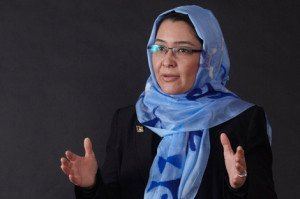
After graduating first in her class from medical school in Afghanistan in 1991, Suraya Dalil, MPH ’05, embarked on a long-planned career in general surgery—until a graveyard filled with children who had died from measles set her on a different path.
“I had never studied this in medical school,” Dalil recalls. “I’d never expected to see a graveyard for hundreds of children who had died within a few weeks from this preventable, treatable disease. That event inspired me. That is how I shifted my path to a career in public health.”
Today, Dalil is minister of public health in Afghanistan, a role she prepared for through studying at Harvard School of Public Health. It was a transformative experience—and possible only because of the award of a full-tuition Presidential Scholarship from Harvard University.
“When I went home I was a different person,” says Dalil, who received her master’s degree in health care management in 2005. “Along with knowledge, the School gave me inspiration and confidence.”
Dalil’s story—like so many others—reflects the critical importance of financial aid throughout the School’s history in creating public health leaders. From the School’s founding in 1913—when fees were a mere $250 (the inflation-adjusted equivalent of roughly $5,898 today)—financial aid has been a pressing need. In its second year, when only seven students were admitted, the leaders of what was then known as the Harvard-MIT School for Health Officers asked University and MIT officials for scholarship money, but to no avail. Instead, students with financial needs received credit toward the School’s certificate—degrees weren’t awarded till 1923—if they worked in public positions during the second semester.
Expensive tuition, low salaries
During the Great Depression, the School’s enrollment dwindled to around half of what was considered optimal, with School officials ascribing the student shortfall to the mismatch between the expense of public health education and the low salaries students would earn after completing their studies. That asymmetry still exists today and is one of the reasons student aid has long topped the School’s funding priorities.
“I would hope no student who comes here would ever have to worry about survival as they seek to spend time studying, learning, and interacting with the faculty and students.” Those words came from former Dean Barry Bloom, who led the School from 1998 to 2008 and is now the Joan L. and Julius H. Jacobson Professor of Public Health. As dean, Bloom made increased student aid his highest priority—a stance adopted by his successor, current Dean Julio Frenk. In recent years, this promise has paid off, with the School repeatedly exceeding its annual fundraising goals for student aid. In the 2013 fiscal year, more than $2.7 million was raised, almost 30 percent above the $2.1 million goal.
Still, this is only a fraction of what is needed. Today, at least 65 percent of the School’s 1,212 students depend on financial aid to cover some or all of their expenses. With total tuition and expenses estimated at more than $69,000 per academic year for an individual student, it’s not surprising that a majority of HSPH students would not be attending without substantial aid. That is especially true of international students, who make up 35 percent of the student population and often come from the developing world.
A quest to prevent dengue fever
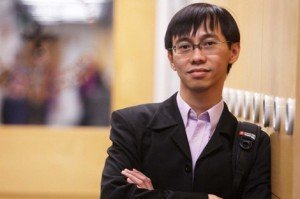
One of these is Panji Hadisoemarto, SD ’14, a doctoral student from Indonesia focusing on dengue fever prevention. In the beginning, HSPH struck him as an impractical aspiration. “I thought, ‘When I go back to Indonesia, I will make something like $300 a month—and have so much debt!’” Hadisoemarto says. “How is that even possible?” That question was answered in the form of a substantial aid package—support that not only makes it possible for Hadisoemarto to pursue his studies but also will make it possible for him to return to a place where his talents and skills are desperately needed.
Daunting debt
But for every Panji Hadisoemarto or Suraya Dalil, there are many qualified students who are unable to attend HSPH because they lack the resources. In addition, many HSPH graduates are forced to make tough decisions, balancing their desire to use their talents where they are most needed against the need to pay off student loans. At graduation, the average debt load of an HSPH student (including undergraduate and any other graduate student loans) is $75,454—a daunting figure for anyone, let alone for those who aspire to lives of public service.
In the aftermath of World War II, the federal government pumped money into higher education, first through the GI Bill and later in response to the Soviet launch of the Sputnik satellite in 1957, which sparked fears that the U.S. was losing its competitive advantage in mathematics and science. Student aid was also part of President Lyndon Johnson’s Great Society program during the 1960s. By the 1977–78 school year, 96 percent of the $1 million in funds for student financial aid (not counting loans) at HSPH came from the federal government.
The current climate is very different. While far more aid is available than in the past, private gifts make up a greater share of the total. During the most recent fiscal year, the School allocated approximately $11 million to student support, with an estimated 80 percent coming from philanthropic giving, notes Kathryn Austin, the School’s director of student financial services.
This donor-fueled expansion in student support has yielded tremendous benefits, including substantial progress toward the goal of funding tuition for all doctoral students in their first two years, Austin says. The funding will boost the School’s competitive advantage in attracting the world’s best students and make it possible for more students to attend HSPH, especially those from developing nations.
“None of our students is in this for the money,” says Austin. “To the contrary, they are willing to come here and often assume debt because they believe they can go out and make a difference. It is such a relief for students to know that they will be able to do what they came here to do. That’s what donors can give them.”
When such support is available, it changes lives, adds Austin. “An alum now working in the developing world recently wrote me to see if I could put her in touch with the donor who funded her scholarship, so she could tell them what an impact that support made on her life.”
Three jobs to stay ahead
The hardest part of her job? Counseling an exhausted student who is working three jobs to avoid becoming saddled with debt that would derail career goals. “Students will cry,” Austin says. “They will say, ‘I don’t know how I’m going to do this.’”
In the end, says Austin, it’s important to keep in mind that scholarship aid is about more than helping students fulfill their dreams—it’s also about having a direct, measurable long-term impact on the global health environment.
Consider Yvette Roubideaux, MPH ’97, who in 2009 became the first female director of the U.S. Indian Health Service, where her goals include addressing chronic diseases and their causes, including diabetes and obesity, in Native Americans. “If we could reduce the obesity problem, that would make a huge dent in health disparities,” she said in a 2010 interview. A member of the Rosebud Sioux tribe, Roubideaux had graduated from Harvard Medical School and spent four years in clinical practice when she enrolled at HSPH with support from what was then the Commonwealth Fund/Harvard University Fellowship in Minority Health Policy.
“We are doing our best to get people into the world to help make it a better, healthier place,” says Austin. “It’s only going to get better if we have money to help more students.”
Faculty + philanthropy = better health for millions
In 1914, Henry Lee Higginson, founder of the Boston Symphony Orchestra and a leading philanthropist of the day, pledged $5,000 annually for five years to support the salary of Richard Pearson Strong, an intrepid investigator of tropical diseases and one of Harvard School of Public Health’s original faculty members. It may not sound like much—until you consider that $5,000 in 1914 equals approximately $117,000 in today’s dollars. Moreover, it laid the groundwork for what would become the School’s first named chair: The Richard Pearson Strong Professorship, which had its origins in the 1927 offer of $100,000—more than $1.3 million in today’s dollars—from an anonymous “friend and admirer of Richard P. Strong.”
The Strong Professorship was ultimately established as a permanent position in 1938, and since then its occupants have racked up an extraordinary list of accomplishments. The chair’s notable incumbents include virologist Thomas Weller, who shared the 1954 Nobel Prize in Physiology or Medicine for the discovery of a way to grow polio virus in nerve tissue cultures, making possible the development of the Salk and Sabin polio vaccines. Along with being a brilliant researcher, Weller was also an adroit, tough-minded administrator who, during his 27 years as chair, spearheaded development of the Department of Tropical Health, predecessor to the current Department of Immunology and Infectious Diseases.
Today’s Richard Pearson Strong Professor of Infectious Diseases, Dyann Wirth, is a renowned tropical disease expert, director of the Harvard Malaria Initiative, and a key leader in Defeating Malaria: From the Genes to the Globe, a University-wide initiative committed to eradicating the life-threatening disease that imperils almost half the world’s population and is especially dangerous to children. While global funding shortfalls currently pose significant challenges, Wirth and her colleagues from diverse sectors and regions around the world continue to push ahead, building on a decade of progress in combating the disease. “Harvard is the perfect place to stimulate thinking about malaria as a complex but solvable problem,” says Wirth, who chairs the School’s Department of Immunology and Infectious Diseases.
Preventing fatal complications of pregnancy
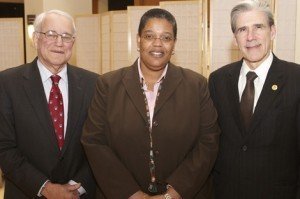
While all HSPH faculty must raise funds through research grants from the National Institutes of Health and other sources to sustain their scientific work, endowed professorships such as Wirth’s give faculty members more time to focus on research, teaching, and other activities central to their mission. The professorships leverage the extraordinary talents of people such as Michelle Williams, SM ’88, SD ’91, a pioneering researcher in the area of reproductive health, whose work focuses on potentially fatal pregnancy complications. Williams’ research combines genomics and epidemiological methods to pinpoint risk factors, diagnostic markers, treatments, and prevention for disorders such as gestational diabetes and preeclampsia, which contribute to maternal and infant mortality. As the School’s first Stephen B. Kay Family Professor of Public Health, Williams continues her cutting-edge research while also serving as chair of the Department of Epidemiology. “I hope that her work can save lives,” says Stephen Kay, AB ’56, MBA ’58, who established the endowed professorship with the simple but profound goal of alleviating sickness and reducing deaths.
Young health policy innovators
Along with supporting the work of established experts, endowed professorships can also create priceless opportunities for younger researchers—as the C. Boyden Gray Associate Professorship of Health Policy and Law did in 2007 for then-junior-professor Michelle Mello, whose scholarly agenda spans the worlds of law, ethics, and public health. The annual support gave Mello the time and freedom to delve into “morally complex” policy and legal issues in the public health arena, including those related to the medical malpractice system, medical errors and patient safety, research ethics, and pharmaceutical regulations. She is now a full professor of law and public health.
To the man who funded the professorship, Mello was a perfect choice. “They couldn’t have picked a better person,” says Harvard College alumnus C. Boyden Gray, AB ’64, whose impressive résumé includes stints as Ambassador to the European Union and service as White House counsel to President George H.W. Bush.
For all their critical importance, endowed professorships remain in short supply at HSPH. Today, fewer than 40 percent of senior professorships, and just over a quarter of all faculty positions, are endowed—a marked contrast to the University’s Faculty of Arts and Sciences, where two-thirds of tenured professorships are endowed. Looking ahead, the School hopes to change this, aiming to endow at least one junior and one full professorship in each of its nine departments.
Download a PDF of Sparking innovation
